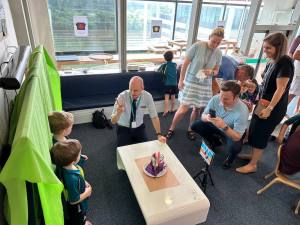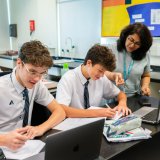Shaking Up Education: The STEAM Challenge of Building Quake-Proof Houses
In the dynamic realm of education, hands-on experiences hold unparalleled significance, especially when it comes to cultivating a deep understanding of scientific principles. Recently, at the Australian International School, our P4 students (ages 4-5) embarked on a journey through a STEAM challenge – Science, Technology, Engineering, Arts, and Math. The mission? To construct a house capable of withstanding the forces of an earthquake. Let’s delve into the intricacies of this stimulating endeavour that not only tested structural integrity but also fostered teamwork, resilience, and innovation.

The STEAM Challenge Unveiled
Under the guidance of Assistant Head of Early Years, Anna Ciezczyk, and Director of Learning Innovation, Adam Torrens, our budding engineers were tasked with an ambitious goal: to build earthquake-resistant houses using rudimentary supplies like blue tac, glue, tape, lolly sticks and wires. This challenge was not merely about erecting structures but about becoming global citizens who think about world events in ways that build resilience and focus on solutions.

The Fourfold Path to Mastery
- Experimentation
Armed with creativity and curiosity, students collaborated to assemble their makeshift houses. With minimal intervention from parents, they explored the dynamics of structural stability, grappling with concepts they had learned in class with their teachers.

- Testing
Once the houses took shape, it was time to subject them to the ultimate litmus test – simulated earthquakes. By varying the intensity of tremors, students witnessed firsthand the repercussions of seismic forces on their constructions. By observing and documenting, they assessed how effective their designs were.

- Improvement
When faced with challenges, resilience became crucial for moving forward. Rather than being discouraged by structures succumbing to tremors or showing weaknesses, students seized the chance to improve their designs. With parental guidance and collective brainstorming, they reinforced the weak points and fortified their houses against future quakes.

- Reflection & Sharing
As the challenge came to an end, it was crucial to share knowledge within the community. Through collaborative reflection sessions, students exchanged insights, strategies, and lessons learned. By sharing ideas on a communal board, they made sure that every member of the year group could benefit from the collective wisdom gained during the project.
Embracing the Reggio Emilia Philosophy
At the Australian International School, we subscribe to the Reggio Emilia approach – an educational ethos that champions experiential, student-driven learning in nurturing, collaborative environments. The STEAM challenge epitomised this philosophy, empowering students to take ownership of their learning journey, fostering resilience in the face of adversity, and fostering a spirit of communal sharing and support.

Fortifying Foundations, Empowering Minds
The STEAM challenge of building earthquake-resistant houses went beyond traditional education boundaries, embodying the values of hands-on learning, resilience, and teamwork. Through trying things out, testing, making improvements, and reflecting, students not only improved their engineering abilities but also learned important life lessons. As we celebrate their triumphs, we reaffirm our commitment to fostering holistic growth and nurturing the next generation of innovative thinkers and problem solvers.
For more information or if you wish to book a tour of the Early Learning Village, please visit our website here.






